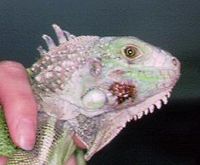Difference between revisions of "Lizard Skin Abscesses"
Jump to navigation
Jump to search
| (One intermediate revision by one other user not shown) | |||
| Line 1: | Line 1: | ||
{{review}} | {{review}} | ||
| − | [[Image:Lizard_abscess1.jpg|200px|thumb|right|'''Abscess''' (Copyright © RVC)]] | + | [[Image:Lizard_abscess1.jpg|200px|thumb|right|'''Abscess''' (Copyright © RVC and its licensors, Sean Bobbit, Sue Evans, Andrew Devare and Claire Moore. All rights reserved)]] |
| − | [[Image:Lizard_abscess2.jpg|400px|thumb|right|'''Abscess''' (Copyright © RVC)]] | + | [[Image:Lizard_abscess2.jpg|400px|thumb|right|'''Abscess''' (Copyright © RVC and its licensors, Sean Bobbit, Sue Evans, Andrew Devare and Claire Moore. All rights reserved)]] |
| − | Most masses in lizards are abscesses or granulomas and they are most common on the head and toes. They are often mistaken for tumours, which are rare in iguanas. Their aetiology | + | Most masses in lizards are abscesses or granulomas and they are most common on the head and toes. They are often mistaken for tumours, which are rare in iguanas. Their aetiology: bacteria, fungi, foreign bodies, Metazoan parasites. |
==Diagnosis== | ==Diagnosis== | ||
Revision as of 17:58, 2 April 2010
| This article has been peer reviewed but is awaiting expert review. If you would like to help with this, please see more information about expert reviewing. |
Most masses in lizards are abscesses or granulomas and they are most common on the head and toes. They are often mistaken for tumours, which are rare in iguanas. Their aetiology: bacteria, fungi, foreign bodies, Metazoan parasites.
Diagnosis
- History
- Physical examination
- Microscopy, culture and sensitivity – aerobic and anaerobic
- Cytology
- Radiography
- Haematology and biochemistry
Treatment
- Excision, preferably with capsule intact
- If lanced, curettage and flushing for several days are extremely important
- Antibiotics

